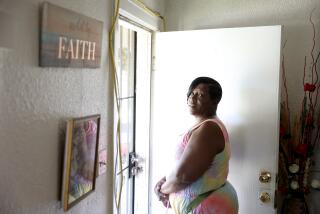What ails L.A County foster care -- and what doesn’t
- Share via
I fully agree with Richard Wexler when he writes in his Sept. 16 Times Op-Ed article, “L.A.’s beleaguered foster care kids,” that the recent tragic deaths of two young children at the hands of their caregivers should not lead to a “knee-jerk” reaction to place more children in foster care. But Wexler’s characterization of the causes of foster care woes in Los Angeles County are so off the mark that I feel compelled to set the record straight.
First, Wexler uses a methodology that tends to inflate the number of children taken into foster care in Los Angeles County, which he says has dramatically increased since 2003. By contrast, the county Department of Children and Family Services’ (DFCS) own numbers unequivocally show that the number of children taken into foster care and the total number of children in foster care actually have declined since 2003. In 2003, there were 28,686 children in out-of-home placement; so far in 2009, that number is 15,648. In addition, from 1998 to 2008, the rate of entries per 1,000 children has been reduced significantly, from 4.4 to 3.6.
Second, the main reasons the vast majority of children enter the foster care system are parental substance abuse and mental illness, not poverty. Although poverty definitely is a serious stressor, in my 40 years of working in the field of child welfare, I have seen few children entering the system because of poverty alone.
Next, it takes the wisdom of Solomon and extensive clinical skills to conduct child-abuse and neglect investigations at the front end. I do agree with Wexler’s contention that there are instances when Children Social Workers (CSWs) leave some children in dangerous homes while removing others who, with adequate supports, could have remained with their own families. While the two errors are directly related, in most cases the reasons for these errors are not because the CSW did not have the time to take the necessary steps to verify a child’s safety.
The real problem, in my experience, is one of skill and experience on the part of CSWs. Put simply, some CSWs do not have the necessary skills to conduct thorough assessments. Many of them are new at the job and inexperienced, as there is a high turnover of DCFS staff because the work is so difficult. CSWs often do not have the clinical skills to properly gather, synthesize and critically analyze the complex information needed to arrive at an appropriate case plan for a child. CSWs must be knowledgeable about physical and sexual abuse, mental illness, parental substance abuse, domestic violence, child development, interviewing skills, coordination with the different systems involved in child-abuse reporting and treatment, the roles of various disciplines involved, legal requirements and on and on.
CSWs, who are the gatekeepers of the child welfare system, need to be drawn from among the most experienced staff in the DCFS; they need to rely on far more than standardized tools for assessing risk. In addition to excellent clinical judgment based on experience and knowledge, they also need strong supervisory oversight and access to consultation and expertise from other disciplines.
Finally, the “landmark study” of 15,000 typical foster care cases cited by Wexler does not yield the clear results he says it does -- that children placed in foster care fare worse than those children left in their own homes. The study’s findings pertain primarily to children whose circumstances put them in the gray areas and are older when placed. The study is not primarily about young, vulnerable children who resided with substance abusing or mentally ill parents; these children represent a very large part of the foster care population. Furthermore, thanks to the increased number of specialized services for foster families in L.A. County, children in DFCS care no longer bounce from placement to placement as often as before. Children also stay in foster care for less time because federal and state law now require that permanent plans be achieved at the earliest possible time. Also, the practice of concurrent planning -- placing children early on with foster parents also willing to adopt if the child is not reunified with the birth family -- has significantly reduced the number of placements for children.
While there is a great deal that can and needs to be done to help children suspected of being abused and neglected, we need first to be clear on the facts.
Susan B. Edelstein, an adjunct assistant professor of pediatrics at UCLA, is executive director of the university’s Training, Intervention, Education and Services for Families program.
More to Read
A cure for the common opinion
Get thought-provoking perspectives with our weekly newsletter.
You may occasionally receive promotional content from the Los Angeles Times.










